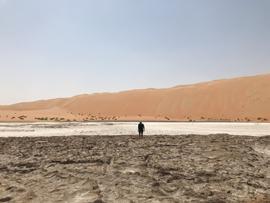
11 minute read
Breathing buildings

Lebanese architect Lina Ghotmeh creates buildings that embody the human experience – “living organisms” that react, breathe and ask questions – while in constant dialogue with their surroundings. With works spanning across Japan, France, Estonia and her hometown of Beirut, Ghotmeh speaks to identity about the power of architecture to reflect on the past in order to inform the present.
Can you tell us about growing up in Beirut – did your impressions of the city impact the way you approach architecture today? Growing up in Beirut left a great mark on my approach to architecture, but also guided my interest in the field in the first place. Beirut is an open archaeology, layered both horizontally and vertically — layers of history and civilisations are constantly unveiled at the start of many constructions. The urban fabric of the city is a direct expression of its inhabitants’ diverse culture. Spatially, it is the city of possibilities and alternatives. Spaces are in constant negotiation with the environment, always revealing very interesting architectural conditions; diverse architectural identities, expressive in their textures, porous through their envelopes and inhabited by an organically growing nature. There is an intensity of life that transpires out of some of these conditions (human, material and natural), one that I always seek in the designs I create with my atelier.
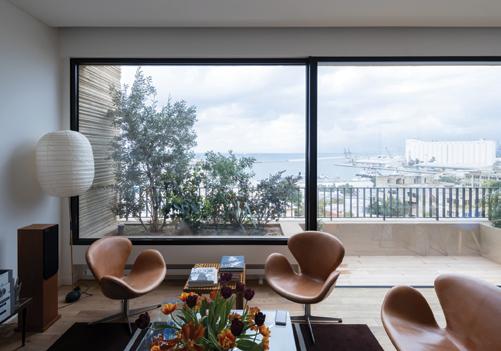
Stone Garden © Lina Ghotmeh — Architecture © Photo Iwan Baan.
Tell us about your interest in archaeology and how that is reflected in your work. I see the built landscape as a breathing body, one that retains the effects of human activity and reacts to them. Every design or every architecture by my atelier is constructed as an emergence, a discovery, even if built anew. Like a palimpsest, scribbled with many narratives (past, present or future), where nothing exists ex nihilo. Every new project is an original, innovative figure shedding a new perspective on a déjà là. This is what I refer to as the ‘Archaeology of the Future’, a projection of our roots into a desirable yet sustainable future; interventions embark my practice into a thorough research, like a detective’s work. We build what resembles a cabinet of curiosities for every project; we look back at ‘traces’ and ‘clues’, [and] actively channel them into newness.
What is the role of architecture for you and how do you aim to apply this approach within your
own projects? [It’s about] elevating the present, making our environment desirable and orchestrating new positive relations. Expressing the essence of what is there, or what precedes, expressing the essence of the materials in use by our designs, engineering the DNA of present ecosystems. Staying in touch and exalting the contexts our architectures live in and, by nature, affect — be it physically, ecologically or anthropologically. In this sense, I see architecture as a living organism, reacting to its surrounding, breathing symbiotically with it, asking questions. Animate rather than inanimate.
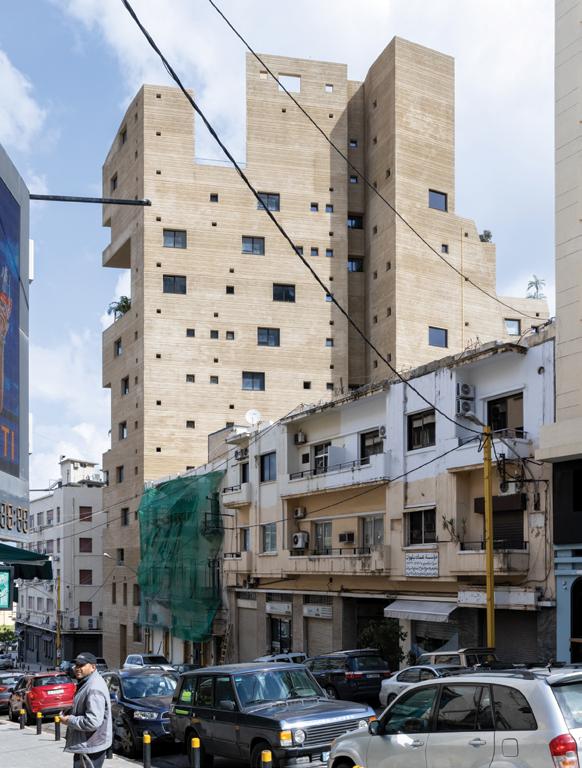
Hermès Workshop © Lina Ghotmeh — Architecture.
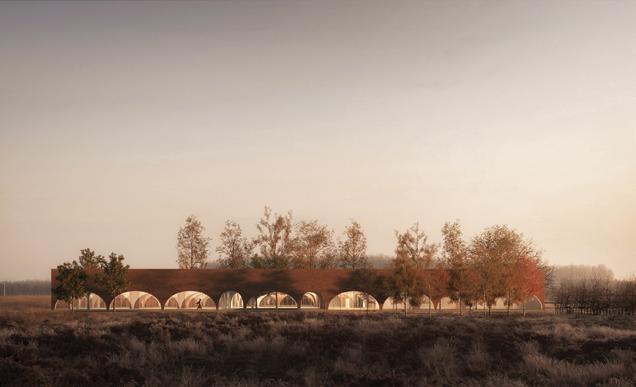
How important is context for an architectural project?
Understanding ‘context’ as the environment, the ‘milieu’ — physical or not — that we are integrating and interacting with, is a major aspect of everything I create as an architect. Architecture has a great responsibility towards its context. It is our duty to assess and be aware of the impact of our work on the framework we intervene in. The quality of the spaces we create has a direct impact on people’s wellbeing. On another level, architecture is also the physical expression of humans’ intellectual achievement; it contributes greatly to shaping human culture, serving as an activator of this constant state of evolution.
Every ‘architecture’ is a process that requires time, thought and empathy.
Can you tell us about the significance of Stone Garden – both in terms of its architecture and what is communicates, but also as your first project in the Middle East and your
hometown of Beirut? Stone Garden was born out of a need to reconcile the human body, nature and the built scape. It is a project that asks multiple questions. Whether related to memory and identity, or to the place we give nature in our built environment, it takes a particular stake towards contemporary architecture. The setting of the building traces vertically the exact boundaries of its site – it chooses to embrace its neighbours instead of rising as a solo cube. Its shape reflects on the invisible building regulations that influence the built scape of our cities, as its angled geometry manifests various setback lines. Windows of different sizes are drawn in continuity to the organic fenestrations seen within neighbouring buildings. Varying in size, they house gardens, planters, flowerpots, include nature as part of our urban habitat and offer, at every level, an individualisation of the apartments. In Beirut, the building echoes specific figures that shape the city’s collective memory: the famous Pigeons’ Rock, the many buildings left derelict, the colour of Beirut’s uncovered earth…
Can you talk about the choice of building envelope finish in the project, and the sense of craftsmanship that lends
the human touch – what were your intentions here? By having artisans hand-chisel the façade, I wanted to allow this sort of ‘imprint of the hand’, this memory of the human body, to add itself to Beirut’s ‘open archaeology’. Like in the sonnet Ozymandias, architecture is an art that stands the test of time — I wanted it to be permeated by our current history, by the current state of our art and our philosophy. The whole building envelope was combed in an artisanal way, as if combing earth to render it more fertile. The process of making this façade felt like a collective healing process, a kind of construction of a vertical inhabitable archaeology.
We had spoken about this before, but it sadly seems like a kind of déjà vu that your first project in the region survived such a horrible incident with the Beirut blast, while a lot of your architecture reflects on the destruction of the Lebanese civil war. Almost a year later, how do you look back at this?
It was uncanny to experience the devastation caused by the blast almost exactly at the time I had been preparing to deliver Stone
Garden. Strangely enough, the event revealed the inherent tale and structure behind the architecture of this tower. Located just a mile away from the explosion, the building’s architectural essence — the structure, the gardens — stood unshaken while the glass got completely blown away. When I went to see the building the day after the event, it felt like I was experiencing the narrative of the building: the past met the present and rendered the future timeless. There was a strange sense of suspension in time. I strongly felt the sense of the milieu and what architecture could say in such a context. Can you talk more about creating human-centric architecture? Why is this important to you? I would not call it human-centric architecture exactly, but would rather say I look for a humane architecture, one that is able to render beauty accessible to all: an architecture that invites the hand to touch, the body to wander and the spirit to flee. An architecture that can bring us closer to each other, to remind us of how connected we are to our environments. As humans, we are part of nature, we are constituted by nature. Thinking of a humane architecture is striving to break the schism between human and nature: aspiring for a more symbiotic, humble way to inhabit our planet.
What are some of the projects that you’re currently working on?
Currently among our projects is our construction of the Hermès Louviers Workshops in Normandy, a project I designed with my atelier, holding very high sustainable ambitions — a low-CO2, passive building. The project is made with handcrafted artisanal bricks and sits calmly in dialogue with its surrounding landscape. Exploring the dancing body and the city, I am also working on the design of the National Choreographic Centre in Tours, [which is] meant to be completed in the coming couple of years. Worth mentioning lastly is a private museum and a house for an art collector in Europe, among others. id

Estonian National Museum. Lina Ghotmeh with Dorell Ghotmeh and Tane Architects © Photo Takuji Shimmura.

Resourceful means
Highlighting the possibilities of alternative cement, the National Pavilion of the UAE for the Venice Biennale invites visitors to pause and reflect on current urban challenges
WORDS BY RIMA ALSAMMARAE
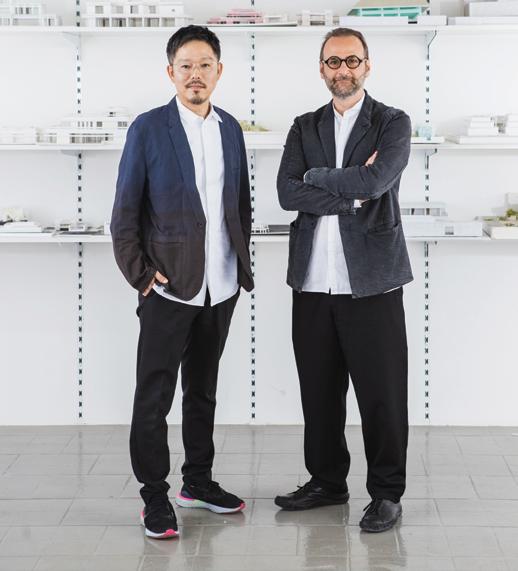
Kenichi Teramoto and Wael Al Awar. Image courtesy National Pavilion UAE La Biennale Di Venezia.
Photography by Seeing Things
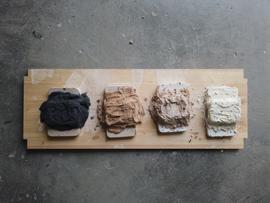
When Hashim Sarkis, Lebanese architect and curator of the 17th Venice Architecture Biennale, called upon architects to question ‘how will we live together’, he prompted very timely responses that focus on global challenges. One such example comes from the UAE, where architects Wael Al Awar and Kenichi Teramoto are experimenting with an alternative cement for the country’s pavilion.
Founders of waiwai design, a multidisciplinary practice with offices in Dubai and Tokyo, Al Awar and Teramoto have long worked to address the social, environmental, economic and technological aspects of architectural projects, and their exhibition for the UAE’s pavilion, entitled Wetland, is no different. Confronting the harmful effects of traditional cement on the climate (cement generates eight percent of the world’s CO2 emissions), the curators will present a structural prototype inspired by the UAE’s sabkha (salt flats) and built from minerals extracted from the rejected brine of the country’s industrial desalination.
“We were looking for a vernacular architecture that is similar to the region, square metre of rain forest. They are and what we found was an architecture the lungs of the UAE.” that used salt in the construction of Al Awar and Teramoto – who buildings in Siwa, a region on the are collaborating with several border of Egypt and Libya,” says Al institutions and agencies including the Awar. “They extracted blocks from environmental agency of Abu Dhabi, the sabkha itself and used mud as glue. the American University of Sharjah, That was interesting to us because the NYU Abu Dhabi and Tokyo University UAE’s landmass is five percent sabkha, – have found a solution in the extracted or wetland.” minerals from the reject brine of
Although vernacular architecture in desalinated water. With the UAE the UAE was typically crafted with coral, having the third largest desalination which Al Awar attributes to the material plant on the planet (and en route to being easier to work with than the having the largest), there are plenty of sabkha, the discovery of Siwa engendered resources to work with and meet the a curiosity in the curators, and triggered demands of the country’s development a years-long research endeavour into plans. According to Al Awar, the building materials that could be made equivalent of nearly 5000 Olympicfrom locally available resources. sized swimming pools of rejected brine
“To be clear, we have zero intention is dumped back into the sea on a daily of using the sabkhas to build with,” basis once it’s been removed from says Al Awar. “They are simply a the sea water during the purification source of inspiration and something process. This waste product can be to learn from. In fact, we are fighting recycled for construction, and the for their preservation because they are UAE’s pavilion will show just that, as carbon sinks – one square metre of Material research at the Wetland lab at Alserkal Avenue. the prototype will be built from 3000 Image courtesy National Pavilion. sabkha can absorb more CO 2 than one units cast in soil and shaped like coral. And while this is the basis of the pavilion’s exhibition, Wetland also aims to address several other ongoing challenges, including what Al Awar refers to as “issues caused by 20th-century individualism” and the modern architect’s neglect of greater responsibility. While both are dense topics to tackle, the pavilion’s team hopes that visitors pick up on its message of collaboration and each person’s responsibility to build a safer future. “Hashim asked us how we will live together, and for us, we saw it as how will humans and nature live together,” says Al Awar. “We want people to really think about collaborating and talking to one another. We could not do what we have done without our partnerships. Through these collaborations, we can live together and develop a better future for ourselves. The 20th century was selfish – it was about the ‘me’, the ‘I’. But now it should be about the ‘we’. It should be about the communal.”
